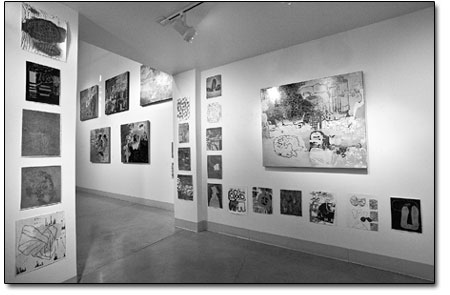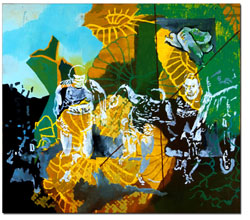| ||||
‘Primarily Painting’
by Jules Masterjohn Many of the artistic styles that have arisen during the last century challenge the viewer to look at art, and life, in a wholly different way. From Picasso’s portraits that simultaneously picture the human face from both the profile and frontal view to Jackson Pollock’s gestures in house paint dripped, spilled and splashed on canvas, art often compels us to ask, “What am I looking at?” Each of these artists’ painting styles asks the viewer to loosen one’s tether to the world as it is seen. From the abstraction of the seen world to that of concepts and ideas, artists reconstruct reality and invite us into the world as they envision it. The modern movements of Dada and then Surrealism did this powerfully, using juxtaposed images filled with incongruities, leading to absurd narratives. Abstract Expressionism took us another step further. Placed in the world of pure color, shape and mark making, the art became both the record of the artist’s process and the end product. Pop Art bridged the gap between fine art and consumer culture by borrowing images from mass media and daily life. Most recently, the Post-Modern movement has opened the doors to a gamut of artistic styles and approaches that hinge on humanity’s passing from an industrial age to an information age. Each of these categorizations is useful in helping us comprehend the evolutionary process of artistic traditions and to better understand the influences within an individual artist’s work. Painter Chad Colby, assistant professor of art at Fort Lewis College, creates paintings that take a bit from each of these aforementioned traditions. His visually dynamic works straddle the boundary between abstract and figurative. His current show, “Primarily Painting,” is a retrospective that chronicles his journey over the past five years while also teaching at the college. If I were to title his exhibit, I would call it “Primarily Pleasure,” for that is what I experience, primarily, from his work. In each of his paintings, there are many layers that overlap, creating a sense of space that waffles between flatness and depth. Aspects of his compositions compete for attention, yet my eyes simply wander, following the complexities of the visual elements throughout the graphically designed and lusciously colored picture plane. Colby places recognizable imagery into his works to hint at a narrative, yet I’m not concerned with figuring out what he intends. I am caught up in his tangle of color, line and shape, absorbing every square inch. Looking at a Colby painting is like an active mediation, giving my busy mind so much to absorb, perhaps, that I just give up and submit to the interplay of the elements, enjoying the moment.
Colby writes in his artist statement, “I’ve always been interested in the power of the collage aesthetic, where visual flotsam of two or more different worlds are slammed together and come to exist in a zone unfamiliar to our standard systems of classification. It is this spirit of playfulness that keeps the work alive for me.” Conceived as “visual riddles or Dada collages,” Colby juxtaposes multiple layers of imagery – from biology, chemistry, industry and mass media. He incorporates aspects of one “system of classification” with another, for instance a fingerprint with the silhouette of an ear of corn, floating in a color field of orange and blue with patterns that resemble genetic material, along with a black-and-white figure of a worker in a chemical suit climbing a ladder up through a metal cage. Through his foundational interest in drawing, paradoxical relationships are created that cannot be brought into a cohesive understanding. This is most evident in the oil on canvas paintings dated from the year 2006, which are presented on the gallery’s main wall. With titles like “Information Office,” “Retriever Room” and “Scientific Conjecture,” one would think that Colby calculates his working process. Rather, he works intuitively, using a process-based approach that allows the imagery and coloration to develop through their interaction on the canvas. These paintings combine visual clues that both “suggest space and cancel it out.” He follows no rules when designing his canvasses and uses a projection device to support his design process. This enables him to move images easily around on the canvas before committing to their placement. The gallery installation, which comprises more than 20 oil paintings, numerous encaustic and oil paintings, two woodcuts, a multi-piece digital photography project, and a series of 40 paintings on paper, complements the artist’s approach. With his a-bit-of-this-and-a-bit-of-that aesthetic, the opening reception also included his three-minute film of a chunk of red color melting into a pot of green wax. He offered, “Some of the projects that I decide to take up are short-lived; these tangents sustain my curiosity and keep my receptors open to new things. However, I always come back to painting.” • “Primarily Painting” is on display through March 20 at the FLC Art Gallery. Gallery hours are 10 a.m.-4 p.m., Mon.– Fri.
|
In this week's issue...
- September 11, 2025
- Back on top
After harrowing flying accident, local highliner steps back out with renewed mission
- September 11, 2025
- New order
Rule change for Land and Water Conservation Fund raises alarms
- September 4, 2025
- Armed with knowledge
Local community organizers work to ensure immigrant neighbors know their rights



